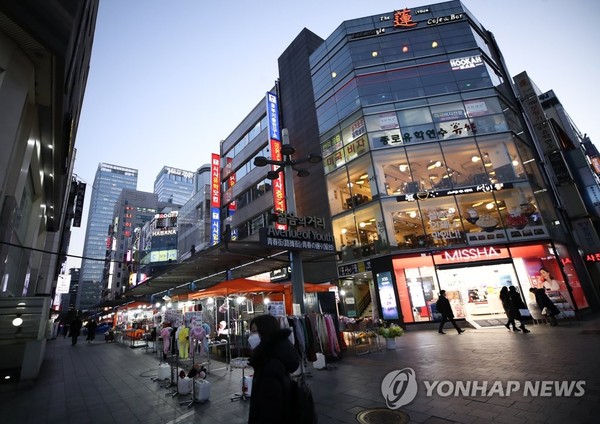The Bank of Korea is again facing pressure to deliver more interest rate cuts to shield Asia's fourth-largest economy from the fast spread of the new coronavirus.
South Korea's central bank is again facing pressure to deliver more interest rate cuts to shield Asia's fourth-largest economy from the fast spread of the new coronavirus that may already be undermining its consumption and exports.
The Bank of Korea (BOK) had widely been anticipated to stand pat on its base interest rate, at least for some time, as the local economy was earlier forecast to rebound from its slowest growth in a decade.
The South Korean economy is forecast to grow 2.3 percent this year, up from last year's 2 percent expansion, the slowest on-year gain since 2009 when it grew 0.7 percent.

We have been expecting to see a rate cut in July at the earliest, but the timing of a rate reduction may be moved up when considering the increased calls for a rate cut by BOK board members and the damage to domestic consumption caused by the coronavirus outbreak," Kim Ji-man, an analyst at Samsung Securities, said.
In the first rate-setting meeting of the year, held Jan. 17, two board members voted in favor of a rate cut, up from one in the previous meeting, held in late November.
The central bank's seven-member board has kept the policy rate steady at 1.25 percent since October when it sent the base rate to the record-low level in its second rate reduction in three months and also three years.
"The possibility of a rate cut in February may be open since the monetary policy board may act preemptively," Kim added. The BOK board is scheduled to hold its next rate-setting meeting next Thursday.
So far, South Korea has reported 27 confirmed cases of the new coronavirus, and more and more citizens are avoiding large crowds and staying home, which many say will lead to a decline in consumption.
"We expect a 0.3 percent contraction from the previous quarter in the first quarter," JP Morgan economist Park Seok-kil said. "It would be a temporary shock but will still affect the annual growth," added Park.
JP Morgan has lowered its annual growth outlook for South Korea to 2.2 percent from the previous 2.3 percent.
Other analysts predict a far worse scenario.
S&P Global Ratings says the outbreak may pull down China's economic growth to as low as 5.0 percent, from 5.7 percent it estimated earlier, by undermining the country's consumption.
"China accounts for one-third of global growth so a 1 percentage point slowdown in the country's growth rate is likely to have a material effect on global growth," it said in a recent report.
Sluggish demand in China will mean bigger problems for South Korea's already slumping exports as China accounts for nearly 20 percent of its overall outbound shipments.
"The new coronavirus outbreak will likely affect the entire global economy from the tourism and retail industries to the manufacturing sector, and its impact will be greater for countries, such as South Korea, that have high reliance on China for exports," Lee Sang-jae, an analyst at Eugene Investment, said.
Economic think tanks here believe a 1 percentage point drop in China's growth rate will trigger a half percentage point dip in that of South Korea.
South Korea's exports sank 10.3 percent from a year earlier in 2019, marking the first on-year decline by a double-digit figure since 2009. Such a drop has been widely been attributed to a 16 percent plunge in shipments to China.
South Korean exports were earlier forecast to grow 3 percent this year, partly on a recovery in shipments to China.
Outbound shipments again fell 6.1 percent on-year in January, marking the 14th consecutive month of on-year drop since December 2018, with exports to China tumbling 10.5 percent.
Moody's Investors Service says the outbreak in China may only be affecting South Korea's retail and automobile industries for now, but that it may begin to affect others if it persists.
"Companies in commodity sectors, such as refining, chemicals and steel, are also exposed to a potential slowdown in economic activity in China, because China represents the single largest source of demand for these industries," it said.
Amid a prolonged suspension of factories in China, many South Korean manufacturers are beginning to face a serious of shortage of parts from their Chinese suppliers.
Top automakers Hyundai Motor and Kia Motors were forced to completely halt their assembly lines Friday.
They were set to partially resume their production Tuesday with parts arriving from Southeast Asian suppliers, but the company said the temporary suspension of production will still have caused a heavy loss in their output.
Many experts here insist the BOK now faces only one relevant question and that is when, instead of if, it will slash the base rate to support the local economy.
"Last year, private consumption accounted for only 0.5 percentage point (in the country's 2 percent on-year growth)," Seoul National University professor Kim So-young said, implying the other 1.5 percentage points have been supported by fiscal spending.
"Economic growth based on government spending is neither sustainable nor effective," he added, apparently suggesting the only option left for the country may be its monetary policy.
Kim Ji-na, an analyst at IBK Investment & Securities, suggested a rate cut in the very near future.
"When the country faced SARS and MERS, the BOK monetary policy board had slashed the policy rate within a month or two while the government devised extra budgets," said Kim.
"An extra budget may be difficult in the near future since the Moon Jae-in administration has already been implementing record high expansionary budgets since its launch, but a base rate cut is a very possible scenario," Kim added.

